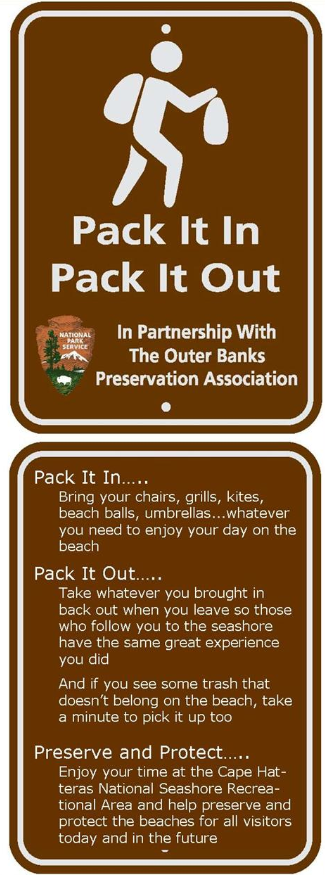Twice a year, OBPA is asked to help pick up trash along N.C. Highway 12 from Buxton Village, north to Ramp 38 in Avon and along the ocean beach from Ramp 38 south towards Buxton Village. This cleanup is an effort by the N.C. Outer Banks Scenic Byways Committee to cleanup the beaches and highways on the Outer Banks. OBPA is asking for volunteers to help is this cleanup effort on Saturday, April 16, 2011. Volunteers will assemble at the Haulover (Canadian Hole) parking lot at 9:00 AM. OBPA, NCBBA and CHAC and other access organizations have participated in this event since 2003. Help us continue to lead the way in helping our island community’s environment look it’s best! Please email or call John Couch at This email address is being protected from spambots. You need JavaScript enabled to view it. 252-995-4955 to join in this worthwhile endeavor.
Read more.....
Comments by NCBBA/CHAPA/OBPA
On NPS Pre-nesting Closure Recommendations
February 28, 2011
The Consent Decree requires piping plover (PIPL) pre-nesting closures beyond that which is required by the Endangered Species Act (ESA), the Migratory Bird Treaty Act, the NPS Organic Act, and NPS Management Policies 2006. After reviewing the 2011 pre-nesting closures proposed by the National Park Service for Bodie Island, Cape Point, South Beach, Hatteras Spit, Ocracoke, and South Ocracoke, the NCBBA, OBPA, and CHAPA recommend the following changes.
American Oyster Catcher (AMOY) nest sites should not be considered a relevant factor, nor shown on any maps of proposed closures for PIPL since the species was not specifically addressed in the Consent Decree.
Bodie Island – Map #1
- The pre-nesting pedestrian and ORV closure at the southern tip of Bodie Island Spit continues to encompass almost the entire land mass. No (0) PIPL nests occurred in that area during either the 2009 or 2010 nesting seasons. With the dredging, erosion and uncertain accretion on this ever changing spit, this extended closure is unwarranted. Should nesting occur outside of a reasonable pre-nesting closure, it can be enlarged. However, if erosion occurs, there is no provision to relocate these overzealous boundaries. The chance of total closure to the safest youth recreation area north of ramp 23 is too great for the NPS to not allow this minimal request. A minimum 100 ft. corridor should be maintained around the entire spit.
- With no (0) nesting of PIPL near the northwestern border of the pre-nesting closure, NPS should reopen the access corridor from the ocean beach to the “Bait Pond.” This corridor could act as a potential barrier between the predators in these dunes and the potential nesting areas on the spit. This corridor will also help keep this area free of vegetation. This entire area is routinely subject to ocean over wash, as it has for the last three (3) years.
- While it appears that the accompanying maps show some increase in the accessible area to the SW of Bodie Spit, the closure for “Pedestrians Only” from the “Bait Pond” southward is unjustified and unreasonable. As evidenced by the NPS aerial photographs, this family beach continues to accrete from the south to the north. The waters adjoining this beach are shallow and warm early in the spring, allowing families with children (and the untold materials they bring for a day’s enjoyment) to utilize this beach from the “Bait Pond” to the southern tip of the Spit. This genteelly sloped beach with minimal wave action loved by our young visitors should be opened to the maximum for the families that flock there every year in pursuit of a safe beach on which their children may play. If NPS enforcement personnel believe that the beach is currently unsafe for vehicles, it should have a safety closure, not “Pedestrian Only,” until it has grown to an acceptable width.
- GPS readings from 2010 vs. 2011 proposals need to be reviewed. A physical check of the exiting carsonite stake placements almost totally close off access to the southernmost portion of the spit in spite of considerable accretion that has occurred in recent weeks.
Cape Point Map #2
-
Cape Point closure should not eliminate the bypass road. The uncertainty of erosion and high water events make the bypass road critically important to access. The bypass should either continue west of the 2009/2010 nests sites to rejoin the access corridor further south, or the bypass should be shortened to join the access corridor further north.
- Relocate the most northern / east pre-nesting closure line, to the southern most point of the bypass trail. This can be allowed because of the natural dune barriers that provide protection of the various bird species from ORVs and pedestrians. These provisions are allowed under the Piping Plover Recovery Plan.
- Move east facing pre-nesting closure line 50m to the west to accommodate reasonable closure expansion. Maintain access to Cape Point to the greatest extent possible.
- Should restore plover habitat on the south and west side of the Salt Pond to encourage plover nesting to safer interior areas, keeping natural dune barriers to protect species.
South Beach Map #3
- Should restore plover habitat on the south and west side of the Salt Pond to encourage plover nesting to safer interior areas, keeping natural dune barriers to protect species.
Over-Wash Fans Map #4
- The availability in 2011 of Pole road as an ORV route to Hatteras Spit is a welcomed improvement to accessibility to the Hatteras Spit area.
- Eliminate Hatteras Spit Over-Wash Fans area pre-nesting closures. This area has no (0) history as plover breeding /nesting areas.
Hatteras Spit Map #5
- The availability in 2011 of beach and sound access at the terminus of Pole road is a welcomed improvement to accessibility to the Hatteras Spit area.
- Eliminate Hatteras Spit pre-nesting closures. Hatteras Spit has no plover habitat. NO areas of PCEs (Primary constituent elements.) Erosion has all but eliminated plover habitat, back interior dune area. No plover nesting activity has occurred at this location in years due to the lack of suitable habitat.
- A 100 ft. access corridor should be maintained around Hatteras Spit.
Ocracoke – Map #6
- Maintain flexible 100 ft. corridor around spit.
South Ocracoke – Map #7
- Maintain flexible 100 ft. corridor around spit.
The OBPA has maintained low membership fees for years. However, the time has come for us to raise our rates.
Effective for 2011, the price of annual renewals will increase to $20. New memberships will cost $35 for the first year, which continues to include the cost of an OBPA license plate and the OBPA decal. Lifetime memberships will remain at $250.
Your are probably already aware that the OBPA team is 100% volunteers. There are no perks or payment of any kind to the individuals who work constantly for beach access in between work and family obligations. All membership fees, donations and proceeds made from fundraisers are used strictly for maintaining access to the beaches of the Outer Banks with most of these funds going to our legal team. 2011 and 2012 are shaping up to be very busy years due to the pending implementation of highly restrictive access rules and regulations.
These increases will be reflected on the notices mailed monthly when membership fees become due, as well as on the membership signup page on the website.
Thank-you for your continued support of the OBPA.
WASHINGTON, D.C. – U.S. Congressman Walter B. Jones (R-NC), Senator Kay Hagan (D-NC) and Senator Richard Burr (R-NC) are pushing for as much public access as possible on Hatteras beaches. The NC delegation members yesterday sent a letter to Department of Interior Secretary Ken Salazar and OMB Director Jacob Lew asking that the proposed off-road vehicle management plan for Cape Hatteras National Seashore provide maximum public beach access. National Park Service officials have prepared a draft rule, which is currently under review prior to being released for public comment.
“The public access restrictions in this proposal are unreasonably excessive and far more than what is necessary for adequate resource protection,” said Jones. “This is a jobs issue. If the Administration is serious about job creation, it will revise this proposal.”
“Beach access is critical to the Dare County economy, and that is why I am working with Representative Jones and Senator Burr to make sure federal regulations are not overly restrictive for the local community,” Hagan said. “The Hatteras community has experienced three summers with many beaches closed, and some local businesses may not survive another. I will continue working with the administration, my colleagues in Congress and all relevant stakeholders to balance appropriate beach access with important environmental protections.”
Congressman Jones has been a longtime outspoken advocate for responsible motorized public access. In January of 2009, Jones introduced H.R. 718, legislation that would reinstate the Interim Management Strategy governing off-road vehicle use on Cape Hatteras National Seashore (CHNS).
In January, Hagan held “Conversations with Kay” in Dare County and talked with Outer Banks residents about their concerns with restrictive public access to North Carolina beaches. Also, Hagan has cosponsored the Preserving Public Access to Cape Hatteras Beaches Act, which would reinstate the Interim Management Plan for off-road vehicles at the Seashore.
To see the full text of the letter to the DOI and OMB click here.
At Hagan's urging, Bonner Bridge replacement will move forward
WASHINGTON, D.C. - At the urging of United States Senator Kay R. Hagan (D-NC) and other members of the North Carolina delegation, the U.S. Departments of Interior and Transportation have endorsed the replacement of the deteriorating Bonner Bridge, which until today has been caught up in government red tape. Since coming to the Senate, Hagan has been seeking a solution that will allow the permitting process for the bridge to proceed without additional extensive and time-consuming studies. She has discussed the issue repeatedly with Interior Secretary Ken Salazar, and in September, Secretary Salazar sent Assistant Secretary for Fish and Wildlife and Parks Tom Strickland to Manteo to see firsthand the bridge's fragile state.
"Today's decision is a critical step toward beginning construction on the replacement of Bonner Bridge, ensuring that safe travel to and from Hatteras Island will be a reality," Hagan said. "One of my key priorities has been to ensure the bridge replacement project could move forward, and today is a real victory for the Hatteras Island community. I am very appreciative that Secretary Salazar and Victor Mendez, Administrator of the Federal Highway Administration, listened to my concerns regarding the critical importance of replacing the bridge."
This past weekend, Secretary Salazar told Senator Hagan about the department's decision to remove roadblocks to the bridge's replacement.
Dating to her time in the General Assembly, Senator Hagan has been closely monitoring this issue along with state Senator Marc Basnight of Dare County. On November 5, Hagan toured Oregon Inlet by boat to examine the state of Bonner Bridge, and met with Dare County Commissioners Warren Judge and Allen Burrus, the U.S. Army Corps of Engineers, and community leaders to discuss the project. Pictures are available here:
http://hagan.senate.gov/files/110510_BonnerBridge_1.jpg
http://hagan.senate.gov/files/110510_BonnerBridge_2.jpg
http://hagan.senate.gov/files/110510_BonnerBridge_3.jpg
The Bonner Bridge links Bodie Island to Hatteras Island and is the vital artery connecting Hatteras Island to the mainland. The bridge was built in 1963 with an estimated lifespan of 30 years. It is now 17 years past the projected retirement date of 1993.


